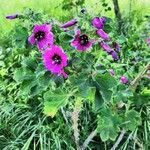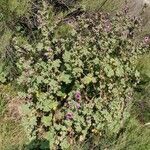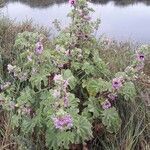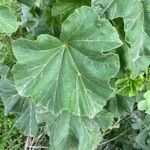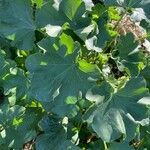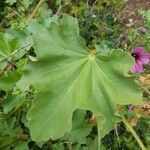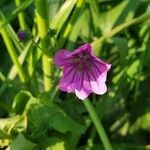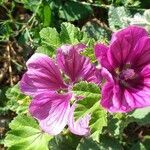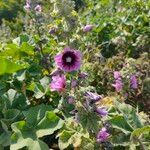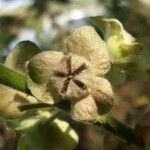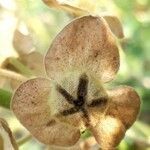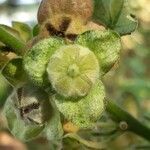Soft-wooded, biennial shrub, 0.5-2.0 m high; stems greyish white. Leaves light green, palmately 5-7-lobed. Stipules narrow. Flowers bright pink or lilac, with dark veins in throat. Epicalyx of 3 bracts, longer than sepals, connate at base. Sepals triangular, acute. Flowering time Sept.-Dec. (or all year). Fruit a discoid to pumpkin-shaped schizocarp, crowned in centre by persistent conical style base. Mericarps 6-8, 1-seeded, dorsal and lateral faces ridged, angles sharp. Seeds reniform.
Annual, biennial or perennial herb, up to 2 m high; stellately pubescent. Leaves with blade orbicular, up to 90 x 120 mm, margins 5-7-lobed. Flowers: in clusters, 2-7-flowered; epicalyx segments fused at base, longer than sepals, broadly ovate, 8-10 mm long, apices obtuse, strongly accrescent in fruit; sepals ± 4 mm long; petals 15-20 mm long, dark pink to lilac with purple veins at base; Oct.-Jan. Fruit with 6-8 mericarps, mericarps ridged.
Glabrescent, thick-stemmed annual or short-lived perennial, up to 2 m tall. Leaves velvety, 3-5-lobed, toothed. Flowers in axillary clusters, mauve, epicalyx cup-shaped and 3-lobed, becoming enlarged in fruit.
Glabrescent, thick-stemmed annual or short-lived perennial to 2 m. Leaves velvety, 3-5-lobed, toothed. Flowers in axillary clusters, mauve, epicalyx cup-shaped and 3-lobed, accrescent in fruit.
Caule herbaceo, demùm basi suffrutescente; foliis plicatis, 7-lobis, lobis rotundatis, junioribus acutis; pedicellis axillaribus, confertis, petiolo multùm brevioribus; coccis rugosis.
